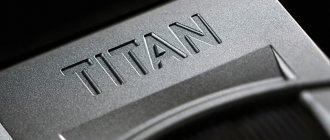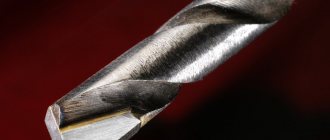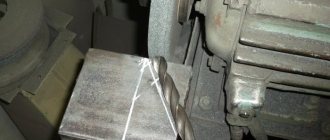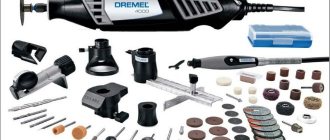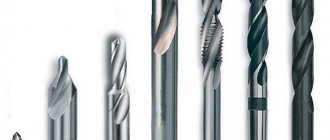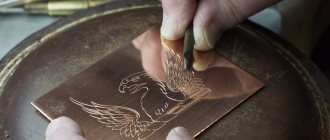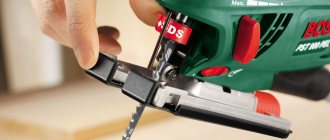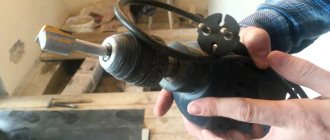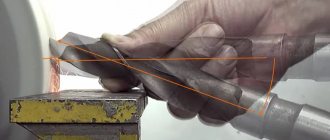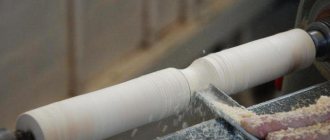17.03.2020
- Types of cutting elements
- Milling cutter material
- Cutter tooth geometry
- Application area
- Technical characteristics of the sharpening machine
- Design Features
- Advantages and disadvantages of using the device when sharpening spiral, disk and other cutters for wood and metal
- Process on the machine: how to properly sharpen cutters for wood and metal
- The process of manual sharpening according to the type of cutter
- Sharpening cylindrical cutters
- Work quality control
In the production process, when working with metal or wood workpieces, machines are an important part. They are equipped with cutting elements. There are many varieties of tools - several thousand items, different in purpose, shape, size. And purchasing new equipment every time at the moment when the edge becomes dull is economically unprofitable. And working with a dull cutter means either breaking it completely, or damaging the equipment itself, ruining the sample. Therefore, regular sharpening of cutters for metal or wood is necessary, and we will tell you how to sharpen tools of different types (end, end, conical, disk, etc.) and at what angle in this article.
Types of cutting elements
Milling is a delicate process that requires a special approach, so craftsmen very carefully select equipment, focusing on different needs. Depending on the material being processed, there are:
- for metal;
- on wood;
- for plastics;
- on glass.
The second important feature is the purpose; cutters are distinguished:
- angular (for corners);
- shaped - depending on the part being processed;
- keyed - to create a special groove with the appropriate name;
- for recesses in the material in the shape of the letter “T”;
- cutting machines for dividing the sample into parts, etc.
Also, when purchasing products, the first thing that is usually called is the shape of the cutter; it can be:
- cylindrical;
- conical;
- disk;
- terminal;
- worm, etc.
It is difficult to list all the types, since for each milling procedure you can buy or even grind your own tool. There are several tens of thousands of items in total, and their range is constantly growing along with increasing production needs. In each variety, the cutting base is quite large in length, regardless of how it is located. Therefore, it is very difficult to ensure correct and uniform sharpening. Sometimes this requires special tools, in other cases meticulous sanding by hand is more suitable. Lack of experience or work done poorly for other reasons can lead to chips, scratches and cracks on the surface on the cutting edge.
Features of sharpening various types of cutters
For metalworking, cutters made of tool or high-speed steel are used. The teeth can be made of carbide materials and secured by soldering. Processing such materials is complex, so sharpening of cutters for metal, especially those with complex cutter shapes, is carried out using specialized equipment. To operate effectively, the machine must rotate and translate the item being sharpened relative to the abrasive wheel and allow the angle of their contact to be changed.
Sharpening of wood cutters (relevant for end cutters) can be done manually with a block or on a regular sharpener at low speeds. The main task is to ensure uniform surface treatment and maintain the original angle. It may not work out at first, but with experience you can achieve good results.
Sharpening spiral cutters is one of the most complex operations and is performed with a cup grinding wheel on a sharpening machine. It is carried out along the back surface of the teeth; a stop is used to ensure a stable angle, otherwise the geometry of the cuts will change and there will be strong runout. The circle is set at a slight angle, the depth of the layer for removal is about 20-40 microns, for cleanliness the pass is carried out 2 times. Sharpening end mills for metal is carried out in a similar way, but an operation with end teeth is added, each of which is set strictly horizontally, the circle moves along at a given angle, while it is important to maintain uniformity of operations for all cutters. Sharpening of hob cutters for metal is carried out depending on the shape of the teeth: for those sharpened along the back, for backed ones at the front.
The service life of cutting tools and the quality of processed surfaces directly depend on the timeliness of sharpening. When working with a dull tool, there is not only an increase in the time required to perform operations, but also a violation of the temperature regime, which in turn leads to deformation of the material being processed and the cutter itself. The process is growing and there may come a time when restoration becomes impossible, and the purchase of new ones will lead to financial costs and possible downtime. The costs of additional sharpening equipment with the active use of a large number of cutters will quickly pay off.
Milling cutter material
Before you start sharpening, be sure to find out what the tool was made from. This may be the following materials:
- Diamond is the strongest mineral of natural or artificial origin, leaves an even cut, is not used so often due to its high cost, and is highly efficient in production with a high class of accuracy.
- Metal ceramics. The advantages include high wear resistance, as well as the fact that the ceramics practically do not heat up (metal with a low melting point does not deform), and also does not actually become clogged with chips.
- Alloys of increased hardness. Their advantage is obvious - they are very hard, so they can process metals with high strength.
- High speed steel. Typically made with high tungsten and/or molybdenum content. The durability grades P9, P12 and P18 are used.
- Carbon instrumental. It is not used very often, since the operation of this type of cutter is possible only at low speeds to prevent deformation.
- Alloyed. It is also allowed infrequently - for shaped cutters that need to process the workpiece at low speeds.
- Hard alloys. They can be used at speeds that are 5-10 times faster than high-speed cutters. At the same time, they do not lose the quality of the cut and can be used even at temperatures above 80 degrees. This can be achieved by titanium, cobalt, tungsten and other elements in the composition. Sharpening of carbide cutters is carried out according to the usual principles; moreover, one tool is enough for a larger amount of work.
How to sharpen a drill important points
If you decide to sharpen a core drill, then it is important to know that it is impossible to do this work at home. The tool is transferred to competent specialists who sharpen it using appropriate equipment.
If, for example, a regular drill can be sharpened on any type of emery or sharpening machine, then in the case of core drills, special technology is required.
Sharpening a core drill is carried out in three stages, where the first is a visual inspection and a preliminary sample of the material. Based on the initial check, you can obtain complete and reliable information about the product.
At the second stage, the sharpener must select the shape of the carved tooth, the number of edges and other points. This moment is considered one of the most painstaking, since special equipment and knowledge are used for the work.
Correctly sharpening a drill will extend its service life and operation. All sharpening work with core drills must be carried out on a special machine, which is impractical to maintain at home.
Today, in order to sharpen drills, there are special companies that use modern equipment and professional staff. By turning to our experts for help, everything will be done quickly and efficiently.
Cutter tooth geometry
Even the most complex metalworking tasks can be solved using a special configuration - this ensures the cutting of end elements of different shapes, for example, the letter “T”.
The geometric solution of the spiral cutter is interesting. The inclination of the teeth can be different, this determines the essence of the operation (finishing or roughing), as well as the cutting step. A small angle is considered to be up to 35 degrees, and a large angle is considered to be more than 35. The standard version is a tilt of 38°.
Detailed information about metal crowns
Review of metal crowns: types, design and main characteristics. Main types of shanks (for drill, machine, etc.). Marking and most important parameters of bimetallic and carbide tubular drills. Differences and main advantages. Selection and sharpening.
The metal bit is designed for drilling large-diameter through holes in sheet and profile metal products. This is one of the few cutting tools that has several parallel names not only in everyday life, but also in professional literature. In GOST 17013-71 it is called a ring drill. But since it has a tubular design of the working part, it is often referred to as a hollow or tubular drill in metalworking textbooks and catalogs of Russian manufacturers. When drilling with such a tool, the cutting process is carried out by teeth located evenly around the circumference of its working end. In appearance, this configuration of the cutting part resembles a crown, so another name for a metal crown is a core drill. And since in its appearance and operating principle it is more similar to a milling tool, you can also find another name - annular cutter.
Application area
Metalworking and woodworking are such common procedures that there are practically no industries where machines are used to some extent. Now the best equipment is CNC. They are the most accurate, fastest and energy efficient. You can purchase them on the website.
Areas of use of milling:
- equipment production;
- production of pipes and rolled metal products of other packaging;
- aerospace factories;
- furniture and interior items;
- fasteners and hardware;
- auto industry and much more.=
They differ in scope depending on the purpose, look at the image:
Sharpening prices
The sharpening price includes the following services:
- Trimming and restoring the end of a drill or cutter
- Sharpening the cutting part (ribbon) and flute
- Removing chips from the cutting part
In addition, we offer clients a “Report” for sharpening cutting tools to optimize costs when using cutting tools, both temporary ones when setting up a machining center, and financial ones associated with equipment downtime. Measurement and reporting is a separate option and is paid separately.
You can find prices for services for sharpening cutters and drills in our price list available on the website or download the pdf version.
Prices are for turnkey sharpening, no additional coefficients or increase in final cost
anaj.ru
How to properly sharpen a cutter for metal: several ways
The main task is to process a curved surface of great length on both sides. In this case, the cutting tool is an abrasive substance. It should be directed directly along the edge (at the correct angle).
How to sharpen using a machine
Technologically, this process occurs in several stages:
- Securing the tool in the desired position in the moving part of the bed.
- Bringing the cutting element to the rotating abrasive wheel until uniform sparking appears.
- Trimming a metal layer up to 50 microns wide.
In this case, the following recommendations must be followed:
- Each tooth needs individual sharpening.
- The movement should occur from the beginning of the furrow to the outer edge.
- All cycles must be carried out in the same way to achieve complete uniformity in the cutting edge.
How to sharpen cutters using sharpening wheels
This is special equipment, the nozzle of which is made of an abrasive substance and is a closed belt:
The peculiarity of turning lies in the correct choice of material. What abrasives do they sell:
- White or classic electrocorundum. It is most often used for ordinary wood or metal cutters.
- Elbor – processes high-speed steel well.
- Silicon carbide or diamond (natural, synthetic) copes well with carbide products.
Recommendation: use cooling lubricants to reduce the thermal effect of friction force.
Using improvised means
To do this, you need a homemade device or a table for a hand router.
Algorithm of actions:
- Using a special liquid, it is necessary to clean the surface of the tool from carbon deposits. To do this, you need to place the cutter in a container and leave it there to soak for 3 minutes, then clean it with coarse bristles.
- Using a diamond stone, grind the edge at the front to ensure longitudinal movement.
- Wipe the finished equipment with a soft cloth to remove metal dust.
Sharpening special tools
Sharpening a special tool has its own objective differences associated with additional stages of the regrinding process.
Tool identification and description
The first step in sharpening special tools is to correctly measure and calculate the required tool geometry parameters. Such measurements are only possible with specialized measuring centers such as ZOLLER Genius3 and WALTER Helicheck.
Measuring centers in this segment are powerful universal measuring instruments for all types of cutting tools.
- Five CNC-controlled axes allow complex, precise and fully automatic measurements without human influence
- Fast and highly accurate tool geometry checking
- Detailed report on measurement results
- Data transfer to the grinding machine without operator intervention
Development of a set of drawings and sharpening program
The information obtained as a result of the measurement is processed and transferred to the tool sharpening program development system. Experienced designers perform all necessary calculations and tool modeling using 3D design tools and carry out simulation and test runs of the program on accurate models of the grinding machine.
Sharpening on a CNC grinding machine
Next, the sharpening program is sent to the grinding center where the operator carries out adjustment and grinding.
For sharpening, machines from famous world leaders such as Reinecker, SAACKE, Deckel, ANCA are used. Thanks to timely maintenance and updating, as well as the professionalism of our CNC operators, we guarantee our customers the required precision and quality of grinding.
Coating
Together with our partners, we apply a wear-resistant coating to the tool using the PVD method (ion plasma deposition in a vacuum). The result is increased durability and quality of processing.
Without a doubt, we will help you choose the appropriate coating for your tool; our specialists will select the optimal type of coating for your specific metalworking task and material.
Specify tool coating as an option on your next tool sharpening order and you'll see results in no time.
anaj.ru
Technical characteristics of the sharpening machine
When purchasing special equipment, you need to carefully consider the following indicators:
- Power supply from 220 V or 360 V.
- Consumption from 200 to 5000 W.
- The spindle rotates without load at speeds from 900 to 3000 per minute.
- Required accuracy class.
- Abrasive wheel feed speed.
- The drive mechanism can be manual or electric.
- What angle can be achieved.
- Are there containers for water or other coolant?
- Availability of a fan.
- The noise level that the machine creates.
- The quality of the protective casing, its strength.
- Floor or tabletop variety.
How to achieve high quality end mill sharpening
The rules listed below are aimed at complying with the established standards of permissible runout and obtaining tools without defects.
- The total runout of the machine spindle, mandrel and fixture must be less than the permissible runout of the cutter being sharpened.
- It is necessary to ensure accurate seating of the grinding wheel. Otherwise, vibrations will not only lead to sharpening defects, but will also accelerate wear of the abrasive device.
- Feed mechanisms should not jam.
- The fixed cutter must be moved as smoothly as possible.
- Machine spindles must have sufficient vibration resistance.
- They need to be well lubricated to ensure they rotate as easily as possible.
- Axial and radial runout should not exceed 0.01 mm.
Design Features
Classic equipment set:
- drive – electric motor;
- belts and other elements of V-belt transmission, with which you can regulate the rotation speed;
- circle, ring with applied abrasive;
- a shelf or other stand for attaching equipment;
- automatic start box and gear shift.
Design and characteristics of core drills
Despite the features of individual models, the basic designs of all metal crowns are approximately the same. All of them consist of a shank, a guide part with spiral grooves and a cutting crown consisting of an even number of teeth (see figure below).
The guide part of such a tool is hollow. When drilling, a metal core is advanced into its internal space, which is knocked out with a special pusher at the end of the operation. The central channel runs through the entire body. A pusher pointed at the end (often spring-loaded) is inserted into it, which, in addition to pushing out the metal core, serves to center the bit on the metal before drilling begins. Also, a centering drill can be attached along the axis of the central channel. In addition, on some models, coolant is supplied to the central channel through a side valve. Due to the large number of cutting teeth, a core drill requires significant cutting force to operate. Therefore, such tools, as a rule, have shanks with flats or grooves for reliable fixation in the chuck. Metal bits designed for conventional drills have a small diameter and cylindrical shanks.
Safety regulations
Follow the recommendations:
- work exclusively on well-established equipment;
- ensure good grounding to avoid possible electric shocks;
- think about fire prevention (no flammable objects near the sparks) and fire extinguishing;
- use personal protective measures.
Pros of core drills
- the ability to produce holes with a diameter of up to 200 mm in one installation of the tool;
- high productivity and, as a result, a significant reduction in cutting time;
- energy saving;
- less wear of cutting edges due to their larger number;
- work at high feeds and low speeds;
- effective cooling of the working area.
Process on the machine: how to properly sharpen cutters for wood and metal
Take a close look at both chucks, one is designed to accommodate a two- or four-flute cutter, and the other is designed for a three-flute cutter. When processing, pay attention to accuracy and uniformity; proper operation will ensure an increase in service life.
Sharpening on a ribbon
First, select a collet chuck that matches the diameter of the tool and the required cup socket. The collet should be inserted into it and tightened with a nut.
Then use the screws to adjust the distance of the metalworking strip. The size can be changed by moving the bottom of the nest down. And at the right place just tighten the screw connections.
Next, the cutter is placed in the chuck, and the required sharpening angle is set. Fastening is done using grooves and pins.
After turning on the feed, you can regulate the movement and layer of metal removal.
Sharpening a cut-off cutter along the end
The machine has a special separate socket for these purposes; we place the tool in it. Moreover, the choice of cartridge depends on how hard the material is - the higher the strength, the larger the socket. The element is processed until the noise stops completely. The item is then transferred to another metalworking fixture from the ends and back.
How to sharpen core drills for metal
When processing metal, it is often necessary to make holes of various diameters in the material.
For such work, only durable tools are used, one of which is a metal core drill. The product produces holes perfectly, but only when sharpened. If, after using a drill for a long time, its performance has decreased, then it’s time to sharpen it again. We will discuss how to properly sharpen a core drill in the proposed material.
The process of manual sharpening according to the type of cutter
Now let's briefly talk about the features of the tool depending on its configuration. The main problems are that it is not always easy to ensure uniform processing along the entire length of the cutting edge.
The peculiarity of manual sharpening is that the emphasis is provided not by the vice of the machine, but by a special device.
End
The cutting elements are located at the end and side. This allows you to make grooves along the edges. Processing takes place according to the following algorithm:
- Fastening of the cutter is horizontal in relation to the rotating one.
- Tilt it enough to achieve the required angle.
- The circle rotates with high amplitude.
- During installation, note the position of the cutting part upwards.
Sharpening end (finger) cutters
This is an elongated tool whose shank has a cylindrical or conical shape. Due to its appearance it has also been compared to fingers. Actions:
- Select a diamond stone to place on the edge of the table.
- If the tool has a large enough recess, then it should be secured along the tabletop.
- As you sharpen, the edge will become sharper and the diameter will decrease.
Recommendation: if the package includes a bearing, then it must first be dismantled, and in any case it would not be superfluous to clean the surface with a specialized solvent.
Disk
Essentially, it is a disk with teeth around its circumference that must be directed upward. If it is simple (unidirectional), then the cutter itself should be positioned vertically. And in the case of a versatile direction, the sharpening angle is the same as the angle of the cutting teeth.
Prefabricated
Their design assumes the presence of removable plates. Each one should be sharpened separately. It should be taken into account that they have several elements for processing - these are rear, main and auxiliary corners, as well as a transition edge.
Cutters with backed teeth
Such an instrument has a flat front surface, and the back is made in an Archimedes spiral. In order to sharpen the product, you must use a disc wheel. Each tooth must be ground down along its outer base, and it is also important to ensure that the same layer of metal is constantly removed.
End mill sharpening angles
To properly sharpen an end mill, you first need to study the geometry of the teeth. They are backed and pointed.
Image No. 1: pointed (a) and backed (b) teeth
The back surfaces of the backed teeth are made in Archimedean spirals. Sharpening of such cutters occurs along the front surfaces.
In pointed teeth, parts of the rear surfaces are planes. Most often, such cutters are sharpened along the rear surfaces. The front ones are treated if necessary.
Let's talk about the geometry of the teeth in detail. Each of them has 4 important parameters.
Image #2: tooth geometry
Surfaces and sharpening angles of end mills.
- Site f. It is this that undergoes the main wear and is sharpened when processing the back surface. The size of the pad directly affects the friction force between the tool and the workpiece. Therefore, the width must be maintained within a certain range.
- Auxiliary clearance angle α1. The cutters are sharpened along it at certain levels of wear and a strong increase in the size of the pads f.
- Main relief angle α. This is the angle between the tangent to the flank surface at the point in question on the main cutting edge and the tangent to the circle of rotation of that point. The purpose of this angle is to reduce friction between the tool and the workpiece.
- Main rake angle γ. Located between the axial plane and the tangent to the front surface. For cutters designed for processing viscous materials, the size of this angle varies from 15 to 20°. Mills for processing steels have an angle of 0 to 5°.
Note! The teeth are either straight or helical. The amount of inclination is characterized by the angle λ. It is located between the axis and the deployed screw edges.
Sharpening cylindrical cutters
The cylinder shape is the most commonly used. Cup circular abrasives are used. You need to attach the equipment to the machine in the center. It should be positioned relative to the rotating circle horizontally and slightly below the axis. Be sure to secure the position with a stop.
Carbide
Grinding is used first; microcracks may form during the process. To eliminate them, finishing is used with the task of removing the layer that was damaged. For this, cast iron discs are used that rotate at a speed of 1.5 meters per second. Finely dispersed carbide paste is used as an abrasive.
Finishing of end mills
If, after sharpening, microcracks are found on the surfaces of the end mill, fine-tuning is applied. Its main purpose is to remove the defective layer. The second task is to improve the cleanliness of surfaces. In addition, during finishing, blockages of the tooth surfaces are eliminated.
Such operations are carried out on sharpening and finishing machines with cast iron discs. With their rotation speeds of 1 to 1.5 m/sec, the best results are achieved. For finishing, boron carbide paste is most often used. Grit size - from 170 to 230.
Photo No. 3: sharpening machine
Diamond wheels can also be used for finishing. When using them, productivity increases by 1.5–2 times.
Sharpening quality control
To restore the original parameters of the tool, it is necessary to select a grinding wheel, the hardness of which allows you to qualitatively obtain the original parameters. At the initial stage, the rear surface is restored. The main task is the correct choice of feed angle to the surface of the grinding wheel. After completing this work, they begin to bring the leading edge to normal condition.
During this operation, it is necessary to control two parameters: the angle of inclination of the tool to the surface of the circle and the size of the bridge being created. The main requirements for the result of this operation are: the formation of both edges of equal length, obtaining the specified angles of inclination. For products in which the technology requires a small back angle, it is advisable to additionally sharpen the back surface. This will reduce friction during cutting and the heating of the tool and workpiece will not increase.
Failure to comply with these requirements will lead to deterioration in the quality of drilled holes and disruption of cutting technology. After the operation is completed, the quality of the obtained parameters is checked. If certain deviations from the requirements were made, the drill is adjusted to the required condition. In enterprises where drills are used to produce a large number of holes, finishing is mandatory.
After completing all technological operations to restore the tool, it is recommended to check its basic geometric parameters. To solve this problem, the following devices are used:
- manufactured templates;
- device developed by V.A. Slepnin.
In the first case, ready-made templates are used, which are made according to a pre-calculated method. Such templates can be purchased ready-made through a retail chain or made independently. Methods for their manufacture are given in specialized literature or on Internet portals.
The basis of the device developed by Slepnin is made up of two disks. They rotate relative to each other. Its main advantage is the variability of possible measurements. This versatility eliminates the need to create a large number of individual templates. Therefore, the time required to check multiple products is significantly reduced.
When checking each tool after completing the sharpening operation, it is necessary to check not only the obtained parameters, but also the equality of the lengths of the opposite cutting edges. If they differ in length, this will lead to an increase in the diameter of the resulting hole. Next, you need to check the change in the clearance angle of the cutting edge. It should gradually increase towards the center of the instrument.
Metal drill sharpening angle
A hole in metal made with a high-quality drill allows you to obtain the required technical characteristics of the finished product. The accuracy of this operation is largely determined by the sharpening angle of the metal drill.
The need for drill sharpening is determined based on an assessment of the following signs:
- increasing drilling time;
- change in the size of the resulting chips (downward);
- violation of the temperature regime (overheating of the cutting tool, the workpiece itself in which the hole is cut);
- the appearance of characteristic mechanical noise during operation
During intensive drilling, the cutting edge becomes dull. Its wear begins at the front corner. At the same time, wear occurs on the trailing edge and the bridge between them. The first sign of a change in the primary parameters of the instrument to the limiting values is a characteristic metallic sound. Hole drilling stops even when the feed speed and force increase.
Precise processing of drill working surfaces ensures high quality holes, increases the speed of operations, prevents overheating, and extends their service life.
Sharpening products of other designs
In addition to twist drills, tools of other designs are used for metal processing. You can debug the following tools at home.
Cone gimlets
You can sharpen a step drill using a regular file. The cutting edge of the product is sharpened at a right angle.
If a cone drill becomes dull in a limited area, then sharpening should be done without going beyond the damaged area.
Crowned
When debugging hole saws, a special device is used and you need to know at what angle the metal should be removed from the cutting surface. Considering all the difficulties and time spent on performing the procedure, it is better to turn to experienced craftsmen for sharpening.
Types of sharpening drills for metal
The procedure for restoring the shape of the cutting surface depends on the selected type of sharpening. The main types are:
- single or normal;
- similar with gradual sharpening (bringing the edge to the required shape);
- single with subsequent editing (pointing) of the transverse edge and ribbon;
- double with a sharpening of the transverse edge or with sequential processing of the edge and ribbon.
The choice of the required type mainly depends on the following factors:
- physical characteristics of the metal in which the workpiece is planned to make a hole;
- diameter of the tool used;
- cutting parameters.
The most common type is the so-called single sharpening. It is used for instruments of small diameter (up to 12 millimeters).

